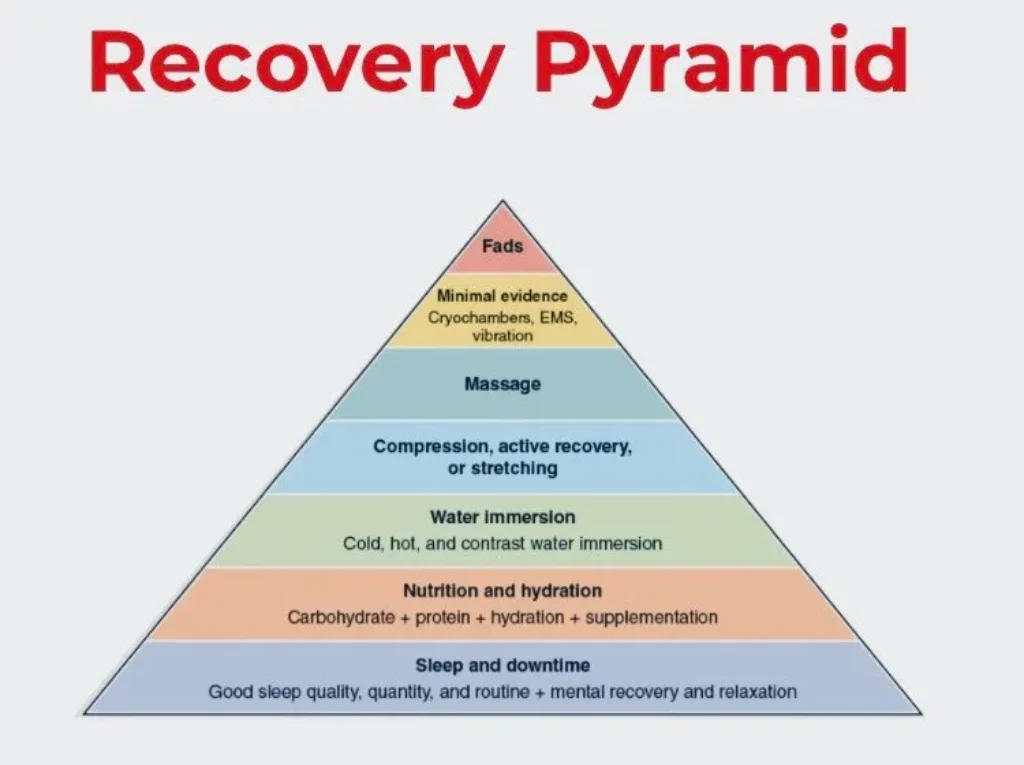How to Spot Overtraining Symptoms Before They Wreck Your Progress

You might be surprised to learn that two-thirds of elite runners show signs of overtraining during their careers. The numbers are even more striking – all but one of these runners, whatever their competitive level, struggle with this challenging condition. This raises an important question: Is overtraining real? The answer is a resounding yes, and it’s not just limited to professional athletes.
This isn’t just about seasoned athletes – anyone starting their fitness journey can face overtraining syndrome. Recovery could take weeks or maybe even months of complete rest. That’s valuable time you could spend reaching your fitness goals.
The silver lining? Your body sends clear signals before serious problems develop. These overtraining signs and overexertion symptoms include unexpected fatigue, muscle pain, anxiety, and poor sleep quality. Your body tells you when it’s reaching its limits.
Want to safeguard your training progress and stay on track with your fitness goals? Let’s take a closer look at these warning signs and learn how to respond to them effectively, including how to avoid overtraining.
What Is Overtraining Syndrome and Why Does It Matter

Overtraining syndrome (OTS) is a serious condition that happens when you work out too hard or too often without enough rest. This doesn’t just affect elite athletes – regular gym-goers who push themselves too hard can get it too. Understanding the difference between overreaching and overtraining is crucial for any fitness enthusiast.
Definition of overtraining vs. overreaching
The stages of overtraining exist on a spectrum with clear differences between them. Overreaching happens when training stress builds up and your performance drops temporarily. You’ll need days or weeks to bounce back. There are two types of overreaching:
- Functional overreaching (FOR): This is a normal part of training that makes you tired but helps you perform better after you rest
- Non-functional overreaching (NFOR): This is more serious and needs longer recovery (usually 2-3 weeks). You might experience mental and physical symptoms
Overtraining syndrome sits at the most severe end of this spectrum. It’s defined as “an accumulation of stress resulting in a persistent performance decrease with or without physiological or psychological symptoms that requires weeks or months of rest to restore”. Functional overreaching helps you adapt and grow stronger. The other two conditions – non-functional overreaching and overtraining – are signs that something’s wrong. You’ll need lots of rest to recover.
Recovery time makes the biggest difference between these conditions. OTS might take months to heal completely. Stress from other areas of life, like mental health, lifestyle choices, and diet, can make overtraining worse.
Why early detection is critical
Catching the signs of overtraining early helps in many ways. You can stop functional overreaching from turning into something more serious, such as NFOR or OTS.
Full-blown overtraining syndrome can have lasting effects. Research shows that approximately two-thirds of elite runners and one-third of all runners experience overtraining syndrome at some point. A 6-month-old case becomes way harder to treat.
The time needed to recover gets much longer as you move along the overtraining spectrum. Functional overreaching needs just a short break, but OTS can keep you sidelined for months. Many athletes think that feeling weak means they should train harder. This pushes them deeper into overtraining, leading to a decline in athletic ability.
Catching it early prevents the flood of physical and mental symptoms that come with OTS. These include constant fatigue, poor performance, mood swings, sleep issues, and a weaker immune system that makes injuries more likely.
The key to great results lies in spotting warning signs quickly and adjusting your training plan. Good monitoring helps you find the sweet spot between challenging yourself and recovering well – that’s how you make real athletic progress. Implementing proper periodization in your training can help prevent overtraining.
Early Signs of Overtraining You Shouldn’t Ignore
Your body tells you something’s wrong long before overtraining syndrome develops fully. These early warning signs can save you weeks or maybe even months of forced rest and recovery. The first signs might seem small, but they stick around and get worse if you ignore them.
Persistent muscle soreness and fatigue
Normal soreness after workouts usually goes away within 24-72 hours. But when you’re pushing too hard, the soreness stays much longer. The main difference lies in how long it lasts—muscle pain that sticks around more than three days after a workout needs your attention.
The way fatigue feels changes, too. You might notice:
- Your limbs feel heavy even on days off
- Simple daily tasks make you feel unusually weak
- You feel more tired with each workout instead of stronger
Your muscles need time to heal between workouts. Without enough rest, inflammation builds up instead of going away. Watch out if your muscle soreness spreads to areas you haven’t even worked out. This could be a sign of over-exercising and overload in exercise.
Mood swings and irritability
The mental effects of overtraining show up before your body breaks down. You might start seeing small changes in how you feel about your workouts. Things that used to pump you up now feel like a drag.
Your mind sends these warning signs:
Decreased motivation – Workouts that used to get you excited now feel like a chore. This goes beyond just not feeling it sometimes—your love for exercise slowly drains away.
Heightened irritability – Little things make you snap, both at the gym and elsewhere. People around you might notice your mood changes before you do.
Anxiety or depression symptoms – While these can happen for many reasons, they often relate to physical overtraining in people who usually don’t have mental health issues.
These mood changes happen because your hormones get out of balance. Your cortisol goes up, and your brain chemicals don’t work right. As your body struggles to bounce back physically, your brain chemistry changes too. This is partly due to hypothalamic dysfunction, which can occur in severe cases of overtraining.
Sleep disturbances and restlessness
Overtraining creates a weird situation where you’re exhausted but can’t sleep. Your body feels tired, but your mind won’t shut off, and the sleep you get doesn’t leave you feeling refreshed.
Look out for these sleep warning signs:
You can’t fall asleep even though your body feels worn out—your mind keeps racing
You wake up throughout the night, especially between 2-4 am, when stress hormones peak
Your heart beats faster while you sleep, which you might notice if you track your sleep
Your hormones cause these problems. Cortisol and adrenaline stay high when they should drop. Good sleep helps you recover, so these issues create a nasty cycle—overtraining ruins your sleep, which makes it harder to recover.
Keeping track of these warning signs gives you the best chance to catch overtraining early. Pay attention to your physical feelings, emotions, and sleep quality. This creates your personal early warning system that spots trouble before serious problems show up. It’s worth noting that female overtraining symptoms may include menstrual irregularities in addition to these common signs.
Advanced Overtraining Symptoms That Signal Trouble

Your body sends clear warning signs before overtraining symptoms turn into serious conditions that affect your performance and health. These advanced symptoms show that your body has moved past simple fatigue. You need immediate attention and help at this stage.
Feeling flu-like symptoms after exercise
You finish your workout and suddenly feel like you’re getting sick. This isn’t just a coincidence. Scientists have found that long, intense exercise weakens your immune system for a while. They call this an “open window” that lasts anywhere from three hours to three days. This makes you more likely to catch bacteria and viruses.
Research with elite male cyclists showed that two hours of intense exercise in a row weakens normal immune function. This happens because exercise creates tiny tears in muscles. These tears release substances that cause inflammation. Without proper rest, this builds up and makes you feel sick. This immune system suppression is a key feature of overtraining syndrome.
These post-exercise flu-like symptoms usually include:
- Nausea and dizziness (in part from Human Growth Hormone release)
- Headaches and general malaise
- You catch colds and respiratory infections more easily
On top of that, these symptoms often show up because you’re dehydrated and not eating properly. Your body just doesn’t have what it needs to recover properly. Glycogen depletion can contribute to these symptoms and is common in overtrained athletes.
Loss of motivation and a performance drop
One of the clearest signs of advanced overtraining creates an odd effect: you work harder but perform worse. Your body should normally adapt to training and get stronger and build more endurance. With overtraining syndrome, the opposite happens.
Research shows that overtrained athletes hit plateaus or see their performance drop instead of improve. You might see your strength, agility, and endurance get worse. This makes reaching your fitness goals harder than ever. Your reaction time and running speed might slow down, too. This decreased performance or performance decrement is a hallmark of overtraining syndrome.
The way workouts feel changes dramatically. Exercises that used to be easy now take much more effort. You work harder but achieve less. This leads to losing motivation, not just occasional unwillingness, but a constant struggle to stay excited about activities you used to love.
Changes in heart rate and blood pressure
Your heart rate patterns give away the most measurable signs of advanced overtraining. Scientists have found several key warning signs:
Your resting heart rate jumping up by 7 or more beats per minute from your normal average suggests you’re not recovering enough. A study of runners in a 500-km race showed their morning pulse rates went up by about 10 beats per minute as they developed overtraining.
On top of that, it takes longer for your heart rate to return to normal after exercise. This happens along with blood pressure changes – it either goes up in sympathetic overtraining (Stage 2) or drops in parasympathetic overtraining (Stage 3). This autonomic imbalance between the sympathetic nervous system and parasympathetic nervous system is a key physiological feature of overtraining syndrome.
Heart rate variability – the time between your heartbeats – drops substantially. Studies link these HRV drops directly to how stressed athletes feel.
These advanced symptoms are serious red flags. They show your body can’t handle your current training levels. You can avoid months of recovery time by spotting these signals early and taking action.
How to Confirm If You’re Overtraining

Self-diagnosis isn’t enough to know if you’re overtraining. You need objective assessment and professional guidance to separate overtraining syndrome from other conditions that show similar symptoms.
When to see a doctor or a coach
The right moment to get professional help can save you from months of needless suffering and training setbacks. You should talk to a healthcare provider or qualified coach if you notice:
- Your performance drops and stays low for more than two weeks, even with proper rest
- You feel tired constantly and don’t feel better after 72 hours of complete rest
- You keep getting sick or infections (especially respiratory ones)
- Your heart rate patterns look unusual (while resting or exercising)
- Mental health issues start affecting your daily life (depression, anxiety)
- You can’t sleep properly for more than a week
Getting help at the right time really matters. Athletes often wait until their symptoms get bad, but early help can speed up recovery. You should reach out as soon as you notice lasting negative changes in how you perform or feel.
Pick your professional based on what’s bothering you. Sports medicine doctors know all about athletic conditions, including overtraining syndrome. Certified strength specialists or experienced coaches can give you a good first assessment. Sports psychologists can help if you’re struggling mentally.
Tests and evaluations are used to diagnose OTS
There’s no single test that can spot overtraining syndrome, which makes it tricky to diagnose. Healthcare providers use several methods to confirm overtraining symptoms:
Performance testing helps doctors see what’s wrong. These controlled tests show if your performance has actually gotten worse. You might do standard time trials, strength tests, or sport-specific skill checks.
Blood analysis rules out other medical issues and might show signs of overtraining. While no single marker proves overtraining syndrome, doctors usually look at:
- Complete blood count to spot infections or anemia
- Hormonal panels (testosterone, cortisol, thyroid function)
- Signs of inflammation and muscle damage
- Iron studies and vitamin D levels
Heart rate variability (HRV) monitoring gives solid data about your recovery status. Less variation between heartbeats associates strongly with overtraining and offers real evidence beyond what you feel.
Doctors also use special psychological questionnaires to check for athlete burnout and overtraining. The Profile of Mood States (POMS) and Recovery-Stress Questionnaire for Athletes (RESTQ-Sport) help calculate the mental effects of possible overtraining.
A detailed training log helps healthcare providers spot patterns that match overtraining syndrome rather than other conditions. This log can also help identify periods of overload in exercise that might have led to overtraining.
How to Recover from Overtraining Safely
Recovery from overtraining syndrome needs more than just time off. Athletes must follow a detailed approach that combines smart rest periods, proper nutrition, and mental health support to bring back physical and psychological balance. This comprehensive overtraining syndrome treatment addresses both the symptoms and the root causes of the condition.
Rest and reduced training load
Rest serves as the life-blood of overtraining recovery, though athletes don’t always need to stop completely. Many athletes benefit more from “relative rest,” according to sports medicine experts. We started with just 5-10 minutes of light daily activity until athletes could comfortably handle one hour.
Athletes should reduce their volume by at least 50-60% when returning to training and increase it by no more than 10% weekly. This slow approach stops the dangerous cycle of early return that leads to recurring symptoms. Recovery periods can range from 4 to 14 weeks based on severity. Some severe cases might need months or even years away from intensive training.
Nutrition and hydration strategies
The body’s nutritional recovery focuses on tissue repair and hormone balance restoration. Daily nutrition should include:
- Enough calories to match energy output (many overtrained athletes don’t fuel properly)
- Protein intake of 1.2-1.7g/kg bodyweight for muscle repair
- Carbohydrates at 8-10g/kg daily to restore muscle glycogen
- Regular hydration throughout the day, not just during workouts
Foods rich in omega-3 fatty acids, like salmon, walnuts, and flaxseeds, help optimize the body’s response to training stress. Proper fueling becomes vital since nutritional gaps can mirror or intensify overtraining symptoms. This nutrition strategy helps combat oxidative stress and supports the body’s recovery processes.
Mental health support and stress management
Mental health recovery deserves equal focus alongside physical rehabilitation. Athletes benefit from working with sports psychologists who provide support during rest periods. Mental skills training with mindfulness, visualization, and relaxation techniques helps athletes prepare for their return to sport.
Quality sleep becomes essential because it supports both physical repair and mental restoration. Healthcare providers often suggest fixed sleep schedules, screen-free bedtime routines, and proper sleeping environments for 7-9 hours of uninterrupted rest.
Conclusion
Early detection of overtraining symptoms is your best defense against months of forced recovery and lost progress. Athletes need to push their limits for growth, but they must understand their body’s signals to maintain the balance between challenge and recovery.
Of course, preventing overtraining syndrome works better than treating it after it develops. Your recovery status becomes clear when you monitor sleep patterns, mood changes, and physical responses after workouts. Heart rate patterns and performance metrics can also help spot problems before they become serious.
Note that athletic success comes from smart training, not endless intensity. You can achieve your fitness goals without overtraining setbacks through proper rest periods, balanced nutrition, and focus on physical and mental well-being. Your body sends signals – listen to them and adjust your training. This simple practice could save you weeks or months of unwanted recovery time.
Learning how to avoid overtraining is crucial for long-term athletic success. By implementing strategies like periodization, maintaining a training log, and paying attention to your body’s signals, you can find the right balance between pushing your limits and allowing for adequate recovery.
FAQs
Q1. What are the early warning signs of overtraining?
Early signs include persistent muscle soreness lasting more than 72 hours, unexplained mood swings and irritability, and sleep disturbances despite feeling physically tired. These symptoms often appear before more serious overtraining issues develop.
Q2. How long does it take to recover from overtraining syndrome?
Recovery time varies depending on the severity of overtraining. Mild cases may require 4-6 weeks, while severe cases can take several months or even up to a year. It’s crucial to follow a gradual return to training under professional guidance.
Q3. Can overtraining affect my immune system?
Yes, overtraining can weaken your immune system. You may experience flu-like symptoms after exercise, increased susceptibility to colds, and respiratory infections. This occurs because intense exercise without proper recovery can suppress immune function.
Q4. How does overtraining impact athletic performance?
Overtraining leads to a paradoxical effect where, despite working harder, your performance declines. You may notice decreased strength, endurance, and agility, as well as slower reaction times. Workouts that were once manageable may suddenly feel much more difficult.
Q5. What nutritional strategies can help prevent overtraining?
To prevent overtraining, ensure adequate calorie intake to match energy expenditure, consume 1.2-1.7g of protein per kg of body weight daily, include 8-10g of carbohydrates per kg daily, and maintain consistent hydration. Additionally, incorporate anti-inflammatory foods rich in omega-3 fatty acids to support recovery and combat oxidative stress.
References
[1] – https://publications.aap.org/pediatrics/article/153/2/e2023065129/196435/Overuse-Injuries-Overtraining-and-Burnout-in-Young
[2] – https://journals.lww.com/acsm-healthfitness/fulltext/2015/03000/overreaching_overtraining__more_is_not_always.4.aspx
[3] – https://www.verywellfit.com/overtraining-syndrome-and-athletes-3119386
[4] – https://www.hss.edu/article_overtraining.asp
[5] – https://www.shape.com/fitness/tips/your-really-freaking-hard-workout-making-you-sick
[6] – https://www.avogel.co.uk/health/immune-system/flu/flu-symptoms-after-exercising/
[7] – https://www.polar.com/blog/overtraining/?srsltid=AfmBOopKCKb19o3iV8zZrex3sZoiX8hG8yBNYClOJ6UFdlS8w3ENOGpw
[8] – https://www.healthline.com/health/signs-of-overtraining
[9] – https://run.outsideonline.com/training/recovery/think-youre-overtraining-check-your-resting-heart-rate/
[10] – https://pubmed.ncbi.nlm.nih.gov/27442738/
[11] – https://my.clevelandclinic.org/health/diseases/overtraining-syndrome
[12] – https://www.fitiv.com/blog/heart-rate-overtraining
[13] – https://pmc.ncbi.nlm.nih.gov/articles/PMC3435910/
[14] – https://www.lifeextension.com/wellness/fitness/overexertion-how-to-recover?srsltid=AfmBOopeGUtaYxEkW6GsUqwRfEPTDUdqYmDzhuXgt8hRLAOrZLVLYgWC
[15] – https://www.trainerroad.com/blog/overtraining-symptoms-recovery-and-avoidance-of-overtraining/
[16] – https://www.uchealth.org/today/rest-and-recovery-for-athletes-physiological-psychological-well-being/
[17] – https://pmc.ncbi.nlm.nih.gov/articles/PMC10708264/
[18] – https://therunningclinic.com/runners/blog/archives-anglaises/nutrition-and-overtraining-is-there-a-connection/






